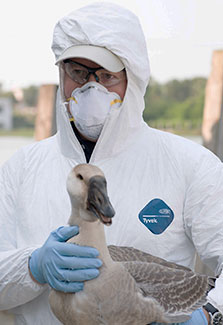Pandemic prevention more effective than response, study says
January / February 2021 | Volume 20 Number 1

Photo courtesy of the EcoHealth Alliance
NIH grantee Dr. Peter Daszak advocates
for a One Health approach to prevent
rather than respond to pandemics.
Unless urgent action is taken to change the global approach to infectious diseases, pandemics will emerge more often, spread more rapidly, do more damage to the economy and kill more people than COVID-19,
according to a recent report issued by a group of the world’s leading experts on biodiversity and pandemics. The cost of COVID-19 in the U.S. alone may reach as high as $16 trillion by the end of 2021, the study estimated. By comparison the price tag for reducing risks to prevent pandemics would be about 100 times less.
The report is the result of a workshop chaired by longtime Fogarty grantee Dr. Peter Daszak that was convened by the Intergovernmental Science-Policy Platform on Biodiversity and Ecosystem Services. The independent body was established by a U.N. resolution in 2012 and is comprised of 130 member countries. In addition, Daszak was a member of the WHO delegation that investigated the coronavirus outbreak in Wuhan, China.
There are as many as 1.7 million undiscovered viruses lurking in animals with up to 827,000 of them estimated to be infectious in humans, the report stated. Human activities that disrupt nature—increasing contact among wildlife, farm animals, pathogens and people—can lead to the moment when an infectious germ jumps from animal to human. Such “spillover” events, made more likely by deforestation, mining activities, land use change and wildlife trade, increase the risk of pandemics.
“We did an analysis of emerging diseases that showed the events that lead to pandemics are increasing in frequency,” said Daszak, who is also president of the nonprofit EcoHealth Alliance. “When is it going to stop? We can’t sustain this level of pandemic impact. If this happened every 10 years, it would be disastrous.”
The report highlights the relationship between financial systems and pandemic risk. “Rapid economic development in low- and middle-income countries often has pretty devastating impacts on the environment and that often leads to health issues, whether that’s pollution, mercury leakage into the rivers or infectious diseases,” said Daszak. “The drivers of that rapid economic growth are customers in richer countries, so it is our globalized consumption patterns that drive economic growth and also drive the risk of pandemics.”
Daszak has led studies of zoonotic diseases with NIH funding for several decades. He received his first-ever federal grant from Fogarty’s
Ecology and Evolution of Infectious Diseases (EEID) program, which supports studies of emerging global threats. With it, he explored the origins of Nipah and Hendra viruses in Malaysia and Australia. Though some thought Nipah emerged due to maybe deforestation, “the real reason turned out to be the dynamics of pig farm production,” explained Daszak. Farms had grown large so farmers segmented pig production, which allowed the virus to continually cycle through the swine population and this caused an outbreak. Daszak says the EEID initiative, which is also supported by the National Science Foundation, is “visionary, ground-breaking and high-reward.”
His Fogarty grants have given him access to places where there is high risk of disease outbreaks, he said. “It’s a win-win. You’re not just doing science but also advancing international relations. It’s helping people in developing countries by building their scientific capacity and teaching them new techniques but it’s also protecting our own health by stopping the spread of disease.”
Today, with support from the NIH’s National Institute of Allergy and Infectious Diseases (NIAID), Daszak is launching a research hub to connect U.S. emerging disease researchers with peers in Thailand, Singapore and Malaysia. These three “economic powerhouses” have an “incredible diversity of wildlife,” said Daszak. “With every species of wildlife there’s a group of pathogens not yet discovered - we can discover them by getting infected or we can go out and try to find them.”
Research teams will collect samples from wildlife and humans in remote communities to identify virus exposure and infection risk. They will also survey communities about their contact with animals and cultural practices to understand the specifics of disease transmission. With the help of local clinics, researchers will learn who’s sick and whether there have been fevers of unknown origin. Then they will use molecular analysis, metagenomics and new serology approaches to characterize these “cryptic outbreaks” and link new syndromes to unfamiliar viruses. Finally, the hub will serve as both an early warning system for pandemics and a standing asset able to scale-up and deploy resources if a disease outbreak were to occur in South East Asia.
Daszak believes scientists and policymakers need to stop expecting “to design our way out of every threat we detect” and begin to prevent problems through better public health measures and by taking a multidisciplinary One Health approach. “We need to better understand why diseases trickle over from animals to humans and cause outbreaks, and what behaviors need to change so we can reduce the need to scramble to produce new vaccines every 10 years.”
More Information
To view Adobe PDF files,
download current, free accessible plug-ins from Adobe's website.
Related Global Health Research Topics